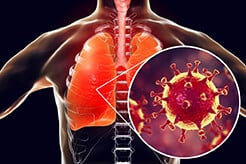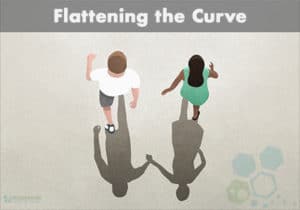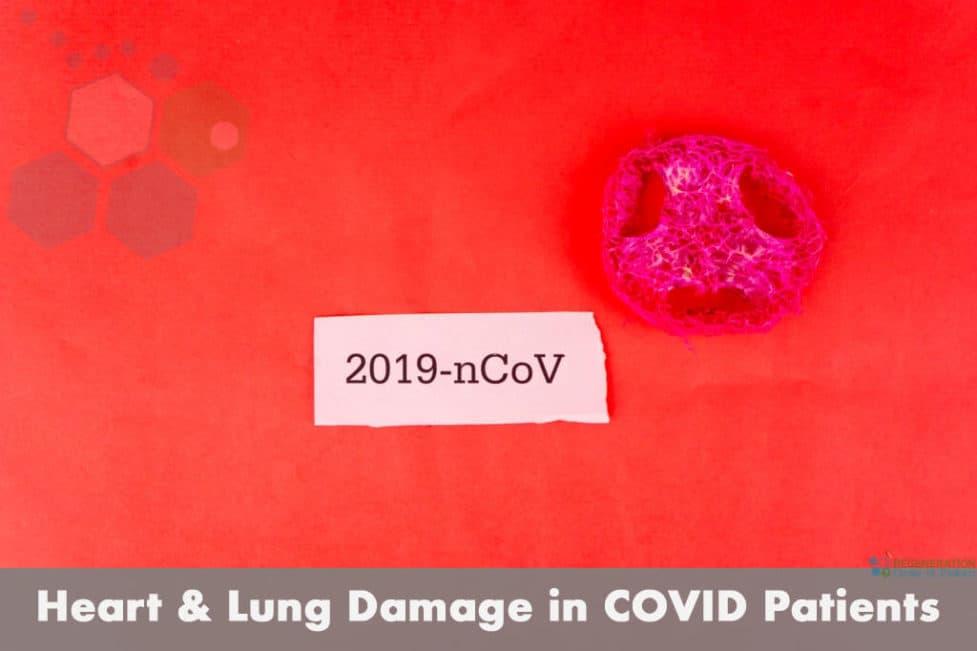While the main focus of doctors dealing with the COVID-19 pandemic has been with pulmonary respiratory problems and securing ventilators, many healthcare workers from the front lines are reporting mysterious heart damage resulting in heart attacks and cardiac arrest.
It is estimated that about 85% of patients that are diagnosed with pneumonia are due to the coronavirus and COVID-19 infection. As more data is released from hospitals in the US, Italy, and China, more cardiologists are finding that the novel COVID-19 virus is also infecting the muscles in the heart. The early reports show apparent cardiac tissue damage in as many as 20% of all patients, resulting in heart failure and even death, despite many of those patients not showing any signs of obstructive pulmonary disease.
These early findings could rapidly change the way healthcare workers need to think about patients, especially those in the early stages of the disease. The results could also create another battle against the global COVID-19 pandemic, with the shifting need for taking extra precautions in patients with diabetes or existing cardiac issues problems requiring additional testing equipment and, eventually, a new treatment protocol to account for patients with damaged heart tissue. Experts believe it’s crucial to understand if the heart is being affected by the coronavirus and what needs to be done about it to save lives.[1]
Preexisting or COVID-19 Virus?
Its difficult to know if the reported heart issues are caused by the COVID-19 virus or the body’s reaction to its presence has quickly become critical unknown facing doctors around the globe as they race to understand the functions of the novel illness better. Understanding how COVID-19 affects heart function is complicated mainly because severe disease and respiratory failure can influence heart health all by itself. A patient who is dying from pneumonia can ultimately die because the heart will stop functioning. If the cardiovascular system cannot get enough oxygen into the system, the primary organs all start behaving erratically. The study also showed that the total number of natural killer cells and CD8+T cells decreased significantly in patients who tested positive for the SARS-CoV-2 infection.
Many cardiologists already believe that the COVID-19 infection does indeed cause damage to the heart in multiple ways, with some patients (who are overweight) getting hit by multiple-vectors simultaneously. Researchers have long understood that any serious and traumatic medical event requiring routine treatments such as hip, spine, or knee surgery, can generate enough stress to damage the heart permanently. An infection in one or both lungs like pneumonia can, therefore, cause widespread hyper-inflammation in the body leading to plaque formation in arteries becoming unstable, resulting in myocardial infarctions.
Rapid inflammation in the body can also result in a medical condition known as myocarditis (inflammation of myocardium), which leads to weakening of the heart tissue and eventually, total heart failure. Early reports show that the damage seen in patients with COVID-19 patients might be directly forming the virus itself attacking the heart muscle. Initial findings also show that the coronavirus attaches itself to specific receptors (ACE2) in the lungs and that these same receptors are also found in heart muscle, causing widespread endothelial dysfunction [2] that can lead to various degrees of acute injuries to multiple organs including the heart, lungs (fibrosis), and kidney failure.
Reports from a retrospective cohort study
In early March 2020, doctors from Wuhan released reports offering a first look at how common heart problems were among patients diagnosed with severe acute respiratory syndrome coronavirus 2 (SARS‐CoV‐2). The study used data from over 450 hospitalized patients and found that nearly 20% of patients showed signs of heart damage that did not exist before they were diagnosed with COVID-19. Almost 52% of those who did show damage to the heart were more likely to die compared to less than 5% of the patients who did not have heart tissue damage. The reports also found that patients with preexisting heart disease before coronavirus infections were more likely to show additional heart damage afterward.[3] The report also concluded that patients with no prior heart conditions who incurred damage to the heart during the infection were more likely to die than those patients that had previous heart disease but did not have COVID-19-induced heart tissue damage.
Due to the small sample size, it’s still unclear why some patients report having more severe cardiac effects than others. Always, it could likely be due to genetic predispositions, a more reliable immune system, or exposure to much higher viral loads. These uncertainties highlight the need for additional monitoring of cardiac markers for patients with COVID-19 patients. Hopefully, doctors in hot spots like New York and London can monitor these lesser-known symptoms to understand better how the virus is affecting the heart. The additional data will help doctors better evaluate patient risk scores and help clinicians properly manage COVID-19 patients moving forward.
Heart Injuries in COVID‐19
One of the more challenging issues, however, is gathering this type of data in times of crisis. Ideally, cardiologists would have time to take cardiac biopsies to determine the heart muscle is infected with the COVID-19 virus.
 Due to the rapid attack of MERS-CoV & COVID-19, most patients are too weak and sick to undergo such an invasive procedure. Furthermore, additional testing could expose other medical staff and hospital departments to the virus. Currently, most hospitals around the world are not using ECG or EKG (electrocardiograms) on infected patients for fear of using limited resources (masks & other protective equipment) or exposing additional staff.
Due to the rapid attack of MERS-CoV & COVID-19, most patients are too weak and sick to undergo such an invasive procedure. Furthermore, additional testing could expose other medical staff and hospital departments to the virus. Currently, most hospitals around the world are not using ECG or EKG (electrocardiograms) on infected patients for fear of using limited resources (masks & other protective equipment) or exposing additional staff.
Since the recent findings, however, cardiologists around the globe are making a coordinated effort to order the additional heart tests needed and recording the data in medical records so they can share what’s going on with other doctors. Hospitals understand the need for compiling the data and sharing crucial information in real-time to help better us fight the pandemic. Even as hospitals get hit by new waves of crisis, researchers are testing new medications and COVID-19 treatments in clinical trials to make sure the results are replicable and validated scientifically.[4]
Additional hurdles after recovery from Coronavirus
That surge of new information has already resulted in positive changes in the way the medical stage is dealing with the heart implications of the COVID-19 virus. Many doctors have reported that the infection can emulate a heart attack resulting in an immediate rush for cardiac catheterization procedures to clear the blockage, only to find that the patient did not have a heart attack but was positive for COVID-19. Standard policy for most hospitals around the world has been to move suspected myocardial infarctions (heart attack) patients directly to bypass emergency rooms in favor of the catheterization lab. This policy is measured as “Door-to-balloon time” and an important metric used to measure how well doctors treat patients with heart attacks. Since the COVID-19 outbreak, many doctors are rethinking this policy so better manage risk for both patients and caretakers. By instituting new intake protocols, doctors are now using an ultrasound scan to confirm if there is indeed a blockage or its viral.
COVID-19 Treatment Options
Currently there are several investigational approaches for treating coronavirus including stem cell therapy, corona-virus vaccines, immunotherapies, antivirals, gene therapies & exosomes. Understanding the virus by sorting out how it affects the heart will help treatment centers to determine which treatments are right for that specific patient so that they can keep them alive. Other factors to consider are that early reports also show that patients who recently recovered from COVID-19 might have other long-term effects due to damage to the heart and lungs.
Published Clinical Citations
[1] ^ Baig, Abdul Mannan, Areeba Khaleeq, Usman Ali, and Hira Syeda. 2020. Evidence of the COVID-19 Virus Targeting the CNS: Tissue Distribution, Host-Virus Interaction, and Proposed Neurotropic Mechanisms. ACS chemical neuroscience, no. 7 (March 13). doi:10.1021/acschemneuro.0c00122. https://www.ncbi.nlm.nih.gov/pubmed/32167747.
[2] ^ Li, Bo, Jing Yang, Faming Zhao, Lili Zhi, Xiqian Wang, Lin Liu, Zhaohui Bi, and Yunhe Zhao. 2020. Prevalence and impact of cardiovascular metabolic diseases on COVID-19 in China. Clinical research in cardiology : official journal of the German Cardiac Society, no. 5 (March 11). doi:10.1007/s00392-020-01626-9. https://www.ncbi.nlm.nih.gov/pubmed/32161990
[3] ^ Li, Yan-Chao, Wan-Zhu Bai, and Tsutomu Hashikawa. 2020. The neuroinvasive potential of SARS-CoV2 may play a role in the respiratory failure of COVID-19 patients. Journal of medical virology, no. 6 (March 11). doi:10.1002/jmv.25728. https://www.ncbi.nlm.nih.gov/pubmed/32104915
[4] ^ Shanmugaraj, Balamurugan, Konlavat Siriwattananon, Kittikhun Wangkanont, and Waranyoo Phoolcharoen. 2020. Perspectives on monoclonal antibody therapy as potential therapeutic intervention for Coronavirus disease-19 (COVID-19). Asian Pacific journal of allergy and immunology, no. 1. doi:10.12932/AP-200220-0773. https://www.ncbi.nlm.nih.gov/pubmed/32134278

